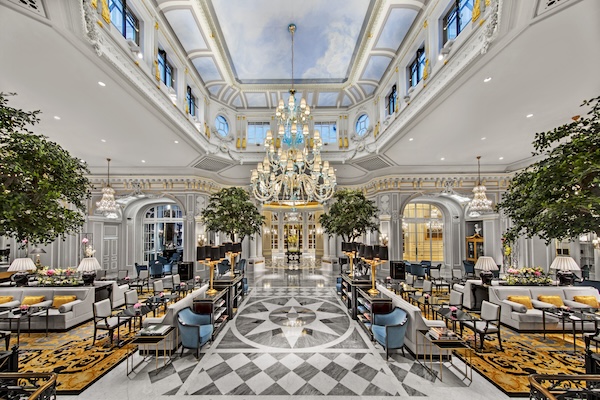When the famed hotelier César Ritz opened The Grand Hotel in Rome in 1894 alongside the legendary restaurateur Auguste Escoffier and with funding from a London consortium that included Gilbert & Sullivan, he set a standard for hospitality that continues to drive premium positioning for the hotel today.
Were Ritz to stroll through the lobby of The St. Regis Rome as it stands today, he might recognize the evolution today’s hotel embodies—a space and operation designed to honor the property’s heritage while delivering what the contemporary traveler looks for in a luxury hotel.
Rooms & Revenue
Today, the hotel has been reimagined as a 138-room, 23-suite property. Guestrooms feature either powder blue or terra cotta color schemes, with furnishings upholstered in Rubelli fabrics. The bathrooms feature travertine or Marquina black marble surfaces, many with terrazzo floors and mosaic insets that reference traditional Roman design elements.
In regard to service, the goal, said General Manager Giuseppe De Martino, is to pair the sophistication of the physical property with an equally elevated level of hospitality, which here includes a personal butler for every guest. This, said De Martino, is “the ultimate grounding of everything we do,” he said.

Operational Philosophy
De Martino, who was named Italian Hotel General Manager of the Year in 2024 by the 470-member European Hotel Managers Association (EHMA), centers his approach on creating connections rather than delivering services in a routine manner. “When guests feel heard, respected and supported, they take ownership of their role and naturally elevate the experience, for themselves and for those of us who are serving them as well,” he said.
Competitive Advantage
The history-drenched location of The St. Regis Rome, which sits atop the ruins of the ancient Roman Diocletian baths, puts guests within walking distance of baroque masterpieces from Bernini and Michelangelo and the Palazzo del Quirinale, one of the largest palaces in the world and the residence of the president of the Italian Republic, with its expansive gardens, renowned frescoes and collection of art and tapestries.
Embracing its location, the hotel aligns its staff to its surroundings with custom Italian fashion-inspired staff uniforms designed by Giada Curti.

Ownership Structure
The property was acquired in 2014 by Constellation Hotels Holding Limited, backed by former Qatari Prime Minister Sheikh Hamad bin Jassim Al Thani, to fulfill, on the seller side, an asset-light strategy. Originally operated by Starwood Hotels and Resorts, Marriott continues to operate the hotel under a long-term management agreement.
The Italian Art of Living
While part of a global brand, The St. Regis Rome maintains distinctly Italian characteristics. De Martino brings a native understanding of Italian hospitality to the property, including what he “inhaled” every day as a child running loose on the Amalfi coast with the children of luxury hoteliers in the area.
At the heart of the hotel’s performance lies “L’Arte di Vivere” or the art of living. This operational philosophy strives to transform routine interactions into memorable experiences, ultimately in the interest of commanding premium rates and increasing guest lifetime value. “Brand leadership is not simply about selling more,” said De Martino. “It’s about inspiring more, creating loyalty beyond reason and driving premiums through unforgettable experiences.”

The hotel’s partnership with Galleria Continua, one of the world’s most prominent contemporary art galleries, demonstrates innovative revenue thinking. Since 2018, this collaboration has transformed the hotel into a living gallery, extending reach beyond traditional hospitality boundaries while creating additional revenue streams through events and cultural programming.
This approach was first manifested in an art installation designed to be visible from the street and thus draw curious local residents and passing tourists into the hotel, a local market penetration strategy that has been increasing F&B revenue and local event bookings. The 2020 establishment of Galleria Continua Roma within the hotel’s Sala Diocleziano wing creates ongoing programming that drives higher-yielding event business.
De Martino sees the hotel’s role as creating transformative experiences that provide genuine cultural insights while maintaining premium service standards. As global hospitality emerges into a new era of traveler expectations, The St. Regis Rome demonstrates how heritage properties can leverage history while embracing innovation to drive superior financial performance. In the “Eternal City,” this 131-year-old property continues to be at the epicenter of what luxury hospitality means today.
Story contributed by Micah Solomon, a leader in customer experience consulting.
